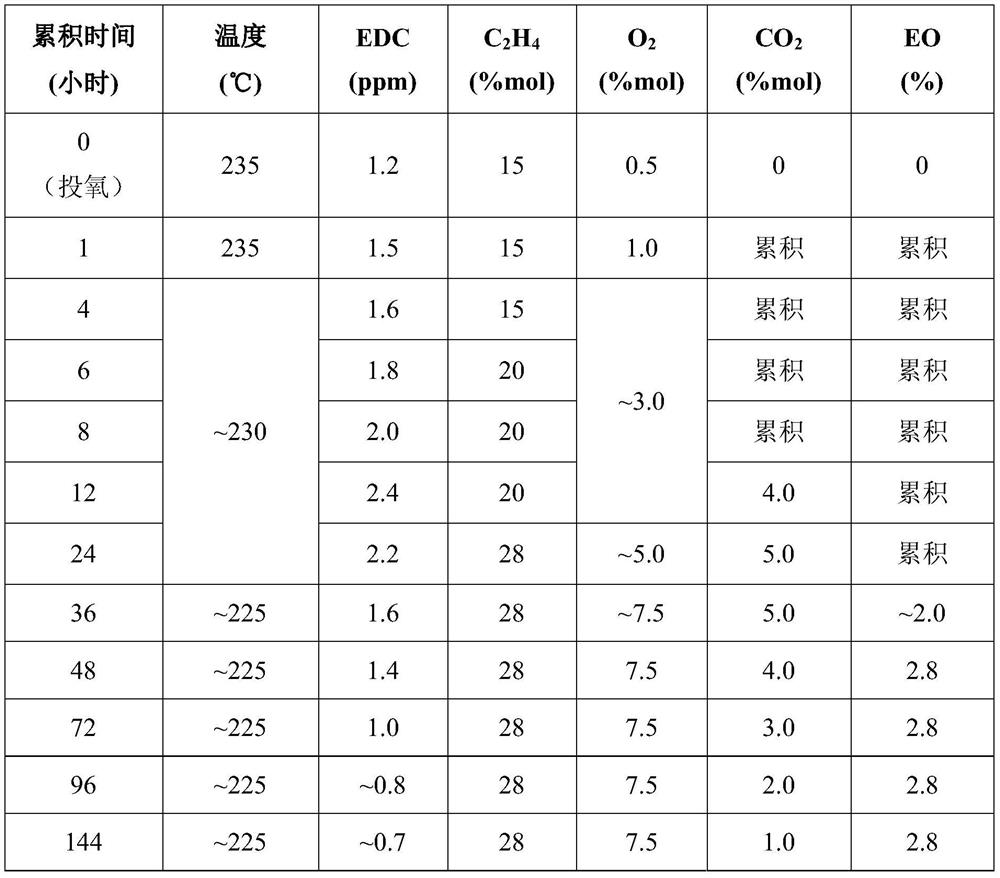Ethylene epoxidation starting method
A technology for ethylene epoxidation and driving method, which is applied in chemical instruments and methods, metal/metal oxide/metal hydroxide catalysts, organic chemistry, etc. and other problems to achieve the effect of avoiding excessive local heat release, rapid selective pull-up, and stable activity improvement
- Summary
- Abstract
- Description
- Claims
- Application Information
AI Technical Summary
Problems solved by technology
Method used
Image
Examples
Embodiment approach
[0024] According to a preferred embodiment of the invention, step S2 includes three stages:
[0025] In the first stage, the regulator is added before adding oxygen, the circulating gas is introduced into the reactor with 50% - 70% of the designed circulating gas volume, and the start-up is started at a constant temperature in the range of 220 ℃ - 235 ℃; Gradually accumulate the carbon dioxide produced by the reaction, so that the inlet carbon dioxide is 3mol% - 5mol%;
[0026] In the second stage, gradually increase the load of oxygen and ethylene to the target load. This step can quickly increase the load of oxygen and ethylene (give priority to increasing the oxygen load), and appropriately reduce the reaction temperature according to the change of reaction bed temperature to facilitate the rapid increase of load. Specifically, the reaction temperature can be optionally reduced by 5-15 ℃; At this time, the circulating gas volume has been restored to 100% of the design circulati...
Embodiment 1
[0054] 1. The catalyst was evaluated in the pilot plant. Preparation before oxygen dosing: before oxygen dosing, nitrogen is introduced into the reactor for replacement, so that the oxygen content in the gas leaving the reactor is less than 0.5%. When the oxygen content in the replacement gas leaving the reactor is less than 0.5%, fill nitrogen to increase the reactor pressure to 1.45-1.5mpa. The heating equipment of the unit is used to maintain the catalyst bed temperature above 230 ℃ for deamination treatment.
[0055] 2. Oxygen dosing preparation: the system keeps the reaction temperature at a constant temperature from 220 ℃ to about 235 ℃ (as 235 ℃ in Table 1), the system pressure is about 1.65mpa, the ethylene concentration is 15.0mol%, and remains stable. At this time, the circulating gas volume is maintained at 50% of the design circulating gas volume.
[0056] 3. For oxygen dosing reaction, refer to the start-up schedule (Table 1):
[0057] When the temperature, pressure a...
Embodiment 2
[0066] Ys series of highly selective silver catalysts were selected in a factory. Before the start-up of the unit, the reactor is filled with nitrogen to replace deamination: without starting the circulating gas compressor for gas circulation, isolate the reactor, introduce low-pressure nitrogen at the inlet of the reactor, punch the reactor to 0.1 ~ 0.5MPa, and raise the reactor temperature to 230 ℃ and keep it unchanged (control the heating rate to be less than 25 ℃ / h). Then exhaust at the low vent point at the outlet of the reactor to continuously discharge the amine removed from the catalyst. The amine content in the exhaust gas is detected once every 4 hours to monitor the change of amine content. The goal is that the amine concentration is significantly lower than the maximum value, and the whole deamination time is 24 ~ 48 hours. Make the unit preliminarily ready for feeding and start-up.
[0067] In the plant system, first put ethylene to 15mol% and keep the system stabl...
PUM
| Property | Measurement | Unit |
|---|---|---|
| Specific surface | aaaaa | aaaaa |
| Pore volume | aaaaa | aaaaa |
Abstract
Description
Claims
Application Information
 Login to View More
Login to View More - Generate Ideas
- Intellectual Property
- Life Sciences
- Materials
- Tech Scout
- Unparalleled Data Quality
- Higher Quality Content
- 60% Fewer Hallucinations
Browse by: Latest US Patents, China's latest patents, Technical Efficacy Thesaurus, Application Domain, Technology Topic, Popular Technical Reports.
© 2025 PatSnap. All rights reserved.Legal|Privacy policy|Modern Slavery Act Transparency Statement|Sitemap|About US| Contact US: help@patsnap.com


